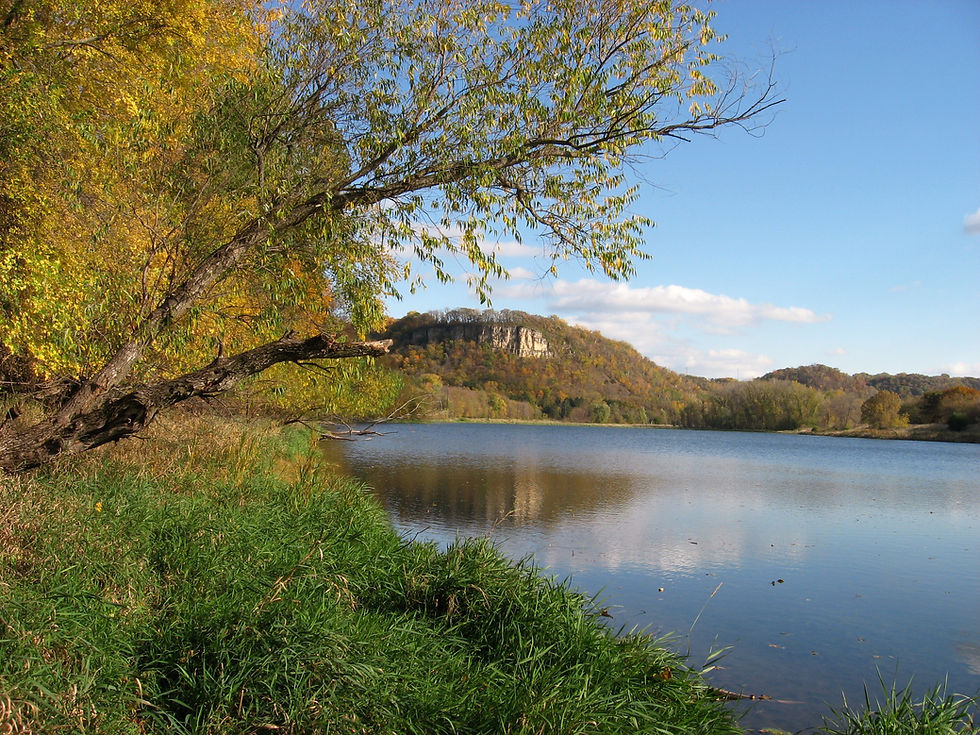Sandhill Cranes Return
- Bruce Ause
- Jul 29, 2018
- 4 min read

During the spring migration, I observed and heard the trumpeting calls of numerous sandhill cranes overhead. Since green-up in mid-May, such activity has been quite rare. Part of the explanation for their scarcity was the adult birds were busy with nesting responsibilities.
On Sunday afternoon July 23, local farmer Dan Tipke harvested his crop of winter rye in the nearby field. Sure enough, on Monday July 24 an adult pair of sandhill cranes were observed gleaning the field for residue rye seeds missed by the combine. Since then a second pair of cranes has been sighted. No doubt more cranes and several Canada geese will arrive in future days.

Wacouta Bay Beaver
As most of you are well aware, the Mississippi River has been unusually high most of June and the first part of July. In the early morning of June 22 with the river level at 11.8 feet, I paddled my solo canoe into the upper reaches of Wacouta Bay.
I suspected with high water, the beaver lodge in that area would be mostly underwater. Hoping by approaching the lodge quietly, I might surprise a beaver or two asleep on top of the lodge. To my delight, one of the largest beaver I have ever observed was sound asleep and let me paddle within 30 feet with camera in hand.
I'm sure this giant fur bearer weighed in at least 65 pounds. Once my presence was detected, it waddled a few feet, quietly slid into the river and a few seconds later violently slapped it's flat tail on the river's surface to warn other members of the colony.

Snapping Turtle
In the evening of July 21, as Kathy and I were walking on the trail, we were summoned across Lakeview Ave by our neighbor Terry Small to check on something in her yard. A huge 25 to 30 pound snapping turtle had wandered into her yard in preparation to dig a hole and lay her eggs. Female snappers will travel long distances over land to find sandy soils in which to lay anywhere from 25 to 80 eggs. Incubation time is temperature dependent ranging from two to four months.

Ruby-Throated Hummingbird Nestlings
I reported in my most recent post on Tuesday June 19, I had the rare opportunity to observe and photograph a female ruby-throated hummingbird incubating her eggs in a delicately woven nest located on a small branch in a sugar maple tree.
These amazing nests are constructed from dandelion down held together with spider silk and sometimes the resin from pine trees. On Wednesday July 11, I took this photo of these two hummingbird nestlings. Once hatched, these nestlings typically are in the nest from 18 to 22 days before fledgling.

Summer View of Wacouta from Rattlesnake Bluff
In the early morning of July 6, I had the good fortune of doing a hike out to the tip of Rattlesnake bluff with Tony Drews and his two sons Samuel and Alex. Tony was a former participant of mine in the early days of the Environmental Learning Center. Tony has lived in Alaska for 30 plus years being employed by an airline maintenance company. Tony is an avid outdoorsman and has taken up the hobby of flintknapping.

Great-Crested Flycatcher Nest, Eggs and Nestling
I also reported in my last post of discovering a great-crested flycatcher nesting in a vacant wood duck nesting box. On Monday July 16, I opened the box to check on the status of the nest. Only one out of five creamy white, brown splotched eggs had hatched. This is one more example of why birds have such a high mortality rate.

Four Point Buck
From mid-June through mid-July, it was very common to observe from 1 to 8 deer feasting on the lush foliage of the soybeans in early morning and just before dark. This nice four point buck with newly developing antlers allowed me to approach him early one morning as I rode my bike along the trail.

Indigo Bunting
One of the most colorful summer birds in Wacouta is the male indigo bunting. Because of it's vibrant color and feeding habits, it is sometimes called a "blue canary." It seems that every morning I ride my bike past a certain spot on the trail, I am serenaded by the cheerful and gusto call of this bird.

Chimney Swift Tower
If you happen to be in Central park in Red Wing across from St. John's Lutheran Church a few minutes before and after sunset during July through mid-August, you will have an opportunity to witness a truly amazing avian spectacle. Hundreds of chimney swifts, sometimes referred to as "flying cigars" will enter the church chimney to roost for the night in a matter of a few minutes.
In May 2014, the Friends of Wacouta embarked on a project to enhance Rattlesnake Bluff trail by constructing a roosting tower near the town hall in an attempt to attract chimney swifts. This tower was built by Goodhue County Sentence To Serve. In the early summer of 2015 and 2016 recorded calls of the swifts were broadcast from the tower near sunset to attract these birds to no avail. I am happy to now report that Kathy and I have recently observed swifts entering and exiting this tower. Check it out near sunset.




Comments